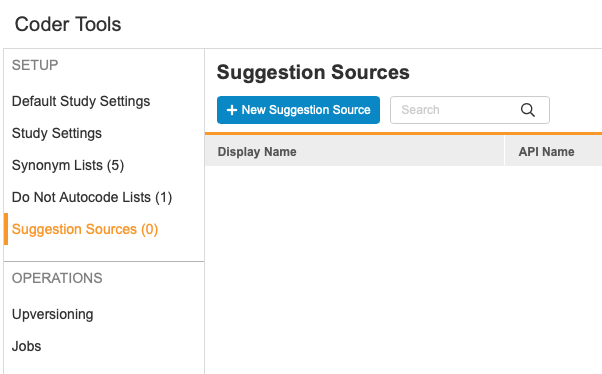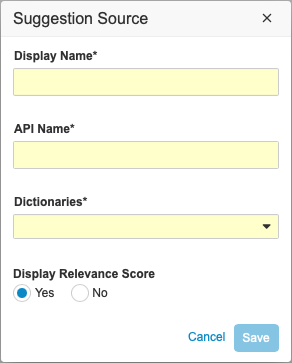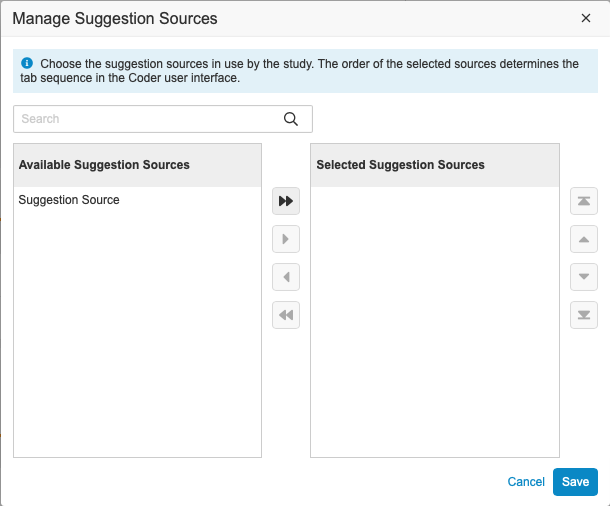Using the Coding Panel
The Coding panel is where Vault Coder shows coding suggestions for Code Requests and where you can search the coding dictionary for terms to code to.
The Coding panel is located at the bottom of the Code Request Listing page. The Coding panel has two (2) subtabs: Suggestions and Dictionary. In the Suggestions subtab, Vault Coder provides suggestions for codes to assign a Code Request, based on an algorithm that compares the properties of a Code Request to the properties of terms stored in the coding dictionary. In the Dictionary subtab, you can search for codes to assign to a Code Request in the coding dictionary associated to the Form (either WHODrug or MedDRA).
Once you locate the term that you want to code to, you can click either Code or Code + Next to assign the code to the selected Code Request. See more details about assigning codes here.
Resize Coding Panel
To resize the Coding panel, click and drag its top border up or down. When viewing suggestions, you may find it helpful to decrease the size of the Coding panel, as you may only be interested in the top few suggestions. In certain cases, you may want to increase the size of the Coding panel when viewing dictionary search results, so that you can view a larger number of results without scrolling.
Open the Coding Panel in a Separate Window
You can open the Coding panel in a separate window by clicking Pop-out (). Once you pop out the Coding panel, you can move it to a second monitor, while continuing to view the Code Request Listing and Code Request Properties panel on your primary monitor.
To move the Coding panel back onto the Code Request Listing page, close the window.
Viewing Suggestions
Once you select a Code Request, Vault Coder automatically compares the properties of the Code Request to records in the assigned coding dictionary. If there are relevant codes, Vault displays them as coding Suggestions in the Coding panel’s Suggestions subtab.
When Vault Coder searches for Suggestions, it looks for specific properties.
For WHODrug (concomitant medications) Code Requests, the application uses three (3) factors of comparison, which are weighted differently:
- Verbatim (influences the suggestion by 50%)
- Route (influences the suggestion by 25%)
- Indication (influences the suggestion by 25%)
For MedDRA (adverse events) Code Requests, Coder only provides Suggestions that are a 100% match for the Verbatim of the selected Code Request.

The relevance score column is configurable in Tools > Coder Tools > Suggestions Sources in the New Suggestion Source dialog.
Third-Party Suggestions
With third-party suggestions, you can select from a list of curated suggestions rather than trying to locate the correct code directly from the dictionary. You can also delete suggestions on a form so that the third-party can generate and post new suggestions for the entire form.
To configure third-party suggestions:
-
Navigate to Tools > Coder Tools and select the Suggestion Sources tab.

-
Click +New Suggestion Source and add a display name, API name, and select the relevant dictionaries.

-
Click Save.
To assign suggestion sources to your study:
- Navigate to Tools > Coder Tools > Study Settings.
-
Add suggestion sources by moving them from Available Suggestion Sources to Selected Suggestion Sources.

- Click Save. Your third-party suggestions will display in a subtab next to the Suggestions subtab in the coding panel.

Viewing Dictionary Search Results
When you select a Code Request in the Code Request Listing table, Vault Coder searches for the Verbatim in the appropriate coding dictionary (WHODrug B3, WHODrug C3, or MedDRA) and will pull dictionary search results directly from the Dictionary Database. Coder displays those search results (exact matches included) in the Dictionary subtab of the Coding panel. You can also search for terms in the Dictionary panel yourself, without selecting a Code Request.


Narrowing your Dictionary Search Results
Coder provides multiple options for modifying the column display in the Dictionary subtab. Adding or removing columns allows you to narrow or expand the scope of your dictionary search results. You can also filter the dictionary search results by clicking a column header.
Sorting
To sort the dictionary search results, single click on a column header. This sorts the results by values in that column in reverse alphabetical order (Z to A). Click a column header a second time to sort the results by values in that column in alphabetical order (A to Z).
Select Columns to Display
You can choose which columns are displayed in the Dictionary subtab:
- Open the Dictionary subtab in the Coding panel.
- Click the Actions menu (). Vault opens the Select Columns to Display dialog.
-
Double-click on columns in the Available Columns section, or click the Arrow buttons, to move columns into the Displayed Columns section. Columns in the Displayed Columns section display in the Dictionary subtab.

- Optional: Click Restore defaults to switch back to the default column display.
- Click Save.
Vault Coder shows only the columns you selected in the Dictionary subtab.
The optional columns for the WHODrug C3 dictionary include:
- Country
- Generic
- MAH
- Name Specifier
- Pharmaceutical Form
- Preferred
- Pharmaceutical Strength
The optional columns for the WHODrug B3 dictionary include:
- Generic
- Preferred
Vault displays all available columns for MedDRA by default. These columns include:
- LLT
- PT
- HLT
- HLGT
- SOC
- Primary Path
Primary Path Filter (MedDRA)
The MedDRA dictionary defines medical conditions. MedDRA codes are organized by System Organ Class (SOC). A MedDRA code begins with the system of the body affected and becomes more specific. The SOC codes are divided into High-Level Group Terms (HLGT), High-Level Terms (HLT), Preferred Terms (PT) and finally into Lowest Level Terms (LLT). So, each MedDRA code can be thought of as a “path” from a broader system of the body which leads to a specific condition which affects the body. MedDRA provides recommended codes for adverse event verbatims called the Primary Path.
For MedDRA forms, Vault Coder displays the Primary Path for dictionary search results by default. The Primary Path column displays either Y (for Yes, when the code is the primary path) or N (for No, when the code is not the primary path).
You can remove the Primary Path filter by clearing the Primary Path checkbox. Once you clear this checkbox, Vault Coder no longer filters the dictionary search results to display codes that are primary paths.
Don’t Disable Primary Path Filter: Veeva highly recommends that you don’t disable the Primary Path filter when coding MedDRA Code Requests.
JDrug
Vault Coder offers JDrug to code and autocode Japanese medications. To code in Japanese, Vault Coder searches the Dictionary using several Japanese scripts, specifically Kanji, Hiragana, and Katakana. Coders may also search the Dictionary with an English phrase and view Japanese results. Both full-width and half-width Japanese and English search phrases are supported.
JDrug users can also Upversion JDrug dictionaries, view Impact Reports, utilize the Propagate Code feature, and import/export a JDrug Synonym List. Learn more about Upversioning and Impact Reports here.
To enable JDrug, you must select a JDrug dictionary when assigning a dictionary to a form in Coder Tools.
Coding from the Coding Panel
The Coding panel is also where you will actually assign codes to Code Requests. Each row, in both the Suggestions and Dictionary subtabs, has Code and Code + Next buttons in the Code Options panel.
Once you locate a code to assign to a Code Request, hover over that code to show the Code and Code + Next buttons. Click Code to assign the code, or click Code + Next to assign the code and immediately move to the next Code Request.
Learn more about assigning codes.
Add a Term to a Synonym List
From the Coding panel, you can add a selected term to the form’s assigned Synonym List. Toggle Add to Synonym List to Y (for Yes) to add the term as a Synonym to the Synonym List for your form (listed next to the toggle switch). Adding to the Synonym List allows Vault Coder to use your coding decisions to influence future autocoding decisions. Learn more about autocoding.



